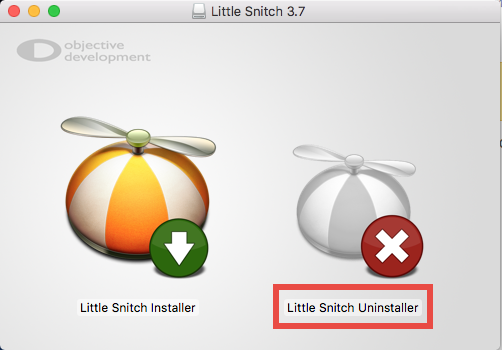Mac Little Snitch Uninstall
- As Little Snitch consists of multiple parts it is essential to run the Little Snitch Uninstaller to make sure all components are removed from your system. Little Snitch 3.4 or newer automatically starts the uninstaller as soon as you move the Little Snitch Configuration into your trash.
- Mar 18, 2009 Little Snitch - Frequently Asked Questions How can I uninstall Little Snitch? Open the Little Snitch Installer application and click the Uninstall button. If you don’t have the Installer available on your computer anymore, you can re-download it from our Download Page.
- Download Mac App Remover 3.1 In the upper-right corner of your screen, click the Magnifier icon to open Spotlight Search. Type “Little Snitch” in the box, and you will see the related folder(s)/file(s). According to the result, respectively drag it (them) to the Trash.
Latest Version:
Requirements:
Mac OS X
Author / Product:
Objective Development Software GmbH / Little Snitch for Mac
Crazy cooking game download for pc. Old Versions:
Filename:
LittleSnitch-3.6.dmg
MD5 Checksum:
88f95ddd7c3e4b7819e7110a8136713a Why cant i download boot camp assistant on mac.
Little Snitch is a firewall which provides your Mac with a safe connection and lets you control the inbound and outbound traffic. But if you’ve decided to uninstall Little Snitch, here are two ways how to do that: the manual way and the automatic way. Open up Launchpad, and type Little Snitch in the search box on the top. Click and hold Little Snitch icon with your mouse button until it starts to wiggle. Then click the “X” that appears on the left upper corner of Little Snitch to perform the uninstall.
Little Snitch informs you whenever a program attempts to establish an outgoing Internet connection. You can then choose to allow or deny this connection, or define a rule how to handle similar, future connection attempts. This reliably prevents private data from being sent out without your knowledge. Little Snitch for Mac runs inconspicuously in the background and it can also detect network related activity of viruses, trojans and other malware.
Features and Highlights
Silent Mode – Decide Later
There are times where you don’t want to get interrupted by any network related notifications. With Silent Mode you can quickly choose to silence all connection warnings for a while. You can then later review the Silent Mode Log to define permanent rules for connection attempts that occurred during that time.
Research Assistant
Have you ever wondered why a process you’ve never heard of before suddenly wants to connect to some server on the Internet? The Research Assistant helps you to find the answer. It only takes one click on the research button to anonymously request additional information for the current connection from the Research Assistant Database.
Automatic Profile Switching
Rules can be arranged in different profiles like “Home”, “Office” or “Mobile Internet”. This allows you to use different sets of filter rules depending on the network you are currently connected to. Profiles can be activated either manually from the status menu, or automatically, whenever you join a network that’s associated with one of your profiles.
Firewall for incoming connections
Little Snitch for macOS not only reveals any outgoing network connection attempt to make sure that sensitive data doesn’t leave your computer without your consent. The inbound firewall in LittleSnitch provides you with the same level of control for incoming connections.
Note: Requires 64-bit processor. The demo runs for three hours, and it can be restarted as often as you like. The Network Monitor expires after 30 days.
Mac Little Snitch Uninstall Download

Assuming you’ve downloaded the Little Snitch Disk Image (.dmg file) to your Downloads folder, open a new Terminal window and enter the following command to verify the cryptographic signature of the downloaded file:

codesign --verify -R='anchor apple generic and certificate leaf[subject.OU] = MLZF7K7B5R' ~/Downloads/LittleSnitch*.dmg
If the result of this command is empty (no error message is shown), the file is intact and properly signed by Objective Development.
Uninstall Little Snitch Mac Os X
However, if an error message is shown (like “not signed at all” or “failed to satisfy specified code requirement(s)”), this indicates that the file was maliciously modified and is no longer signed by Objective Development. In that case you should NOT open the disk image file.



